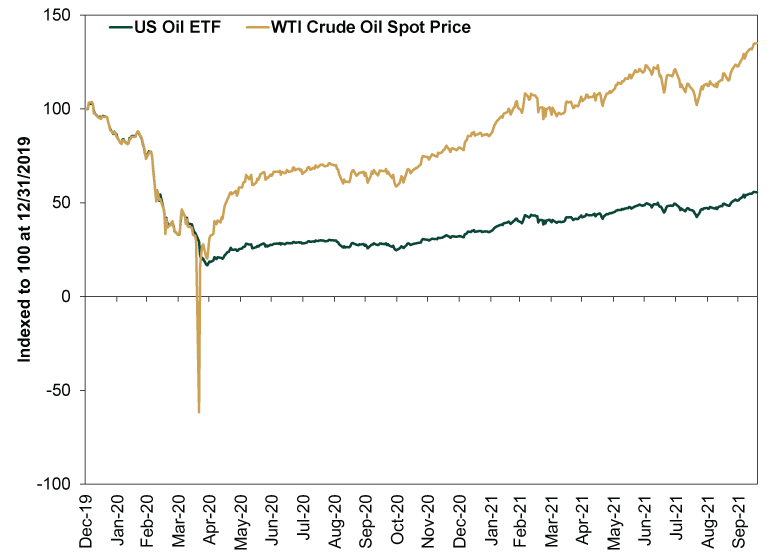Personal Wealth Management / Market Analysis
Lessons From Oil on the New Crypto Futures Fund
Always know what exactly you are buying.
Editors’ Note: MarketMinder doesn’t make individual security recommendations. This piece aims to hit on a broader theme illustrated by the securities discussed.
If you so much as peeked at the financial news world Tuesday, you likely saw there is a new ETF in town. Some, playing fast and loose with terminology, call it a bitcoin ETF, the first of its kind, a landmark development for investors. Finally, people can invest in bitcoin without venturing into the Wild West of crypto wallets and zero investor protections! There is one teensy little problem with this claim: It isn’t a bitcoin ETF. The fund actually manages bitcoin futures, and it may not end up tracking bitcoin’s price well at all. That is just one reason we are issuing a friendly buyer beware to anyone considering this. We aren’t inherently against it or bitcoin, or securities tracking bitcoin futures. But understanding what you are reviewing to properly weigh risks is key to making any investment decision.
People have been trying to get bitcoin ETFs off the ground for years. The Winklevoss twins started the push in 2013, but the SEC rejected multiple applications, citing concerns about market manipulation, illiquidity and outsized volatility. Several asset managers also tried and hit that brick wall. But over the summer, the SEC changed its guidance to imply it would bless funds that packaged bitcoin futures, rather than actual bitcoins. Unlike cryptocurrencies, futures trade on regulated exchanges, where officials can monitor for unusual and suspicious activity. So ProShares, a fund provider, got to work on the Bitcoin Strategy ETF, which will hold only bitcoin futures contracts. The SEC gave the green light last week, and it debuted Tuesday with ProShares execs ringing the New York Stock Exchange’s opening bell.
If you find yourself wanting to buy this, we suggest asking a simple question: Why? A parallel question: Why is this happening now? Well, probably because bitcoin is back near all-time highs after a massive summertime slump. It looked quite frothy when it first crossed $60,000 back in April, during a massive boom in all things digital (including joke cryptocurrencies like dogecoin and digital collectibles known as non-fungible tokens, or NFTs). Then came the hangover, which let the air out of crypto, special-purpose acquisition companies (SPACs) and other speculative assets.
Now bitcoin is bouncing back, and several asset managers are trying to follow in ProShares’ footsteps. While we don’t see as much froth in this niche area of markets as we did early this year in alternative cryptocurrencies or when SPAC ETFs rolled out just as the genre was peaking, we do see this bandwagon as a sign the broad optimism we discussed then persists now. Bandwagons are a big sign of heat chasing—they happen because everyone wants to get a piece of the thing going up, up and away. If bitcoin weren’t booming again, there probably wouldn’t be a race to own it. Witness the lack of investor interest over the summer, for example. Now, not only is there massive interest based on past price movement, but pundits are arguing bitcoin futures funds’ existence is a huge bullish driver for bitcoin itself. Their forecasts are increasingly outlandish, reminiscent of Dow 36,000.[i] “It is up and people say it will go way higher” is not a good investment thesis, in our view.
Perhaps you disagree and want to take a flyer on bitcoin anyway, which, everyone is free to choose! But if that is the case, a bitcoin futures fund may not deliver the results you are looking for even if bitcoin rockets to the moon. Futures ETFs tied to volatile commodities tend to have a large tracking error, which—in plain English—means the fund’s price doesn’t track the commodity’s price accurately. A futures contract is an agreement to purchase a commodity at a set price on a given date. Unless you intend to take physical delivery of that commodity, you must roll over your contract—sell the maturing one and buy a longer-dated one. This is what the bitcoin futures ETF managers will spend their time doing, and the associated costs add up, especially if long-dated contracts fetch higher prices than short-term contracts. This phenomenon, known as contango, means that every time a fund manager rolls over a contract they must sell low and buy high, which further jacks up costs and erodes returns. As The Wall Street Journal noted last week, bitcoin futures are often in contango, potentially setting this fund up for a rough ride.
This isn’t a mere theoretical headwind. You can see the actual effect in the United States Oil ETF (USO), which made headlines in April 2020 for its wild divergence from crude oil prices—and not to owners’ benefit. Back on April 20, 2020, West Texas Intermediate (WTI) crude oil’s spot price dipped into negative territory due to some very technical quirks in the futures market. USO did not, which we figure is good. But a lot of people bought USO that day, thinking it would give them exposure to what was sure to be a quick bounce in crude. Instead, while WTI crude’s spot price jumped back into positive territory on April 21, USO fell -25%. It fell again the next day, while WTI’s spot price rose again. In response, USO switched from same-month futures to contracts expiring several months ahead and effectively transformed itself into a closed-end fund so it couldn’t get caught flat-footed by the need to create new shares (and buy the underlying securities) if people flocked to it en masse. Exhibit 1 shows the effect of the huge divergence on returns since.[ii]
Exhibit 1: USO Shows the Risks of Futures Funds

Source: FactSet, as of 10/19/2021. United States Oil Fund LP price and WTI crude oil spot price, 12/31/2019 – 10/18/2021.
Every investment decision is a tradeoff. When you buy stocks, you accept the risk of short-term volatility in exchange for the likelihood of high long-term returns. With a bitcoin futures ETF, we surmise you are accepting the risk of tracking error in exchange for the transparency and investor protections that come with owning a regulated fund. Some investors might think the tradeoff is worthwhile. Some might not. Some might want to avoid bitcoin entirely, concluding that speculating conflicts with their long-term goals. Only you know what the right decision for you is—just ensure you make that decision with all the relevant information and risks in mind.
[i] “Bitcoin Equilibrium Price Likely to Top $168,000 Following ETF Approval, FSInsight Says,” Will Canny, CoinDesk, 10/19/2021. Also, incidentally, Dow 36,000 is finally approaching, just 16 years later than the forecasters predicted.
[ii] Yes, yes, we know. USO and its ilk are meant to be short-term trading instruments and not investments one holds. But that didn’t stop many investors from doing the latter, in our experience, and the former is a rather dodgy strategy, in our view.
If you would like to contact the editors responsible for this article, please message MarketMinder directly.
*The content contained in this article represents only the opinions and viewpoints of the Fisher Investments editorial staff.
Get a weekly roundup of our market insights
Sign up for our weekly e-mail newsletter.

You Imagine Your Future. We Help You Get There.
Are you ready to start your journey to a better financial future?

Where Might the Market Go Next?
Confidently tackle the market’s ups and downs with independent research and analysis that tells you where we think stocks are headed—and why.





